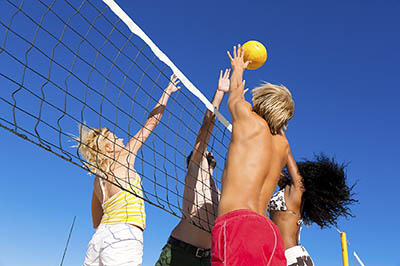 Watch a beach volleyball tournament to witness some truly fit athletes at work—success in volleyball requires many different physical skills, abilities and attributes.
Watch a beach volleyball tournament to witness some truly fit athletes at work—success in volleyball requires many different physical skills, abilities and attributes.
You can up your game on the courts this summer, and get the lean strong look that goes with it, when you incorporate volleyball training moves into your usual workouts.
Training to become a well-rounded athlete is the key to getting the beach volleyball body, and a big part of mastering the sport. Players must be as explosive as a sprinter and still have the endurance to last in a match that can run for hours.
There is also a matter of finesse—to improve your volleyball performance you’ll need control and balance, especially to stabilize on the soft court underneath you. And don’t forget powerful shoulders and range of motion for those hard spikes and long reaches, too.
With all that in mind, no wonder beach volleyball stars look so good! Consider adding in the following training elements to your strength and conditioning routine if you want to rock the courts…and the beach shorts!
What You Need: Power.
You’ll be squatting, pushing off and jumping—you need explosive power to move the lower body. And your upper body needs power to block, spike and serve.
What to Do: Add Olympic lifts for power, especially squats, power clean and Romanian deadlift. Beginners can start with bodyweight, a bar only or dumbbells. Overhead presses, lunges are helpful, too, reflecting some of the movements of volleyball. Beginners can start with bodyweight, a bar only or dumbbells. For more explosive power, medicine ball moves like tossing it with a partner, or plyometrics like box jumps. Try working hard on the rowing machine, too. Power depends a lot on speed.
What You Need: Speed.
You’ll need to get around the court quickly with your big, strong muscles and count on your smaller muscle groups for fast moves. To deal with the speed of serves and hard ball smashes, reaction time matters as well. Speed not only contributes to power, it also factors into agility.
What to Do: Try adding some speed drills like multi-directional sprints. Many top volleyball players also rely on a HIIT routine—it’s a well-rounded workout for athletes and the spurts of high-intensity work can contribute to speed training. You might also incorporate dynamic effort using relatively lighter weights moved at max speed.
What You Need: Agility.
The ball changes directions and angles and you’ll need to react to play it; that means changing your own direction and angles, too, with swift coordinated efforts.
What to Do: Agility drills are often part of a boot camp program or group exercise class focused on conditioning. Since changing directions is an important part of the sport, add exercises like shuffle steps done side to side, single and double leg hops, work with a reaction ball or speed bag, and jumping rope in patterns just like a boxer.
What You Need: Endurance.
With each game (or set) played to a winning score of 21 points and another deciding set of 15 points possible, you’ll need to last through volley matches that take a long time and a lot of energy. If you’re playing outdoors, weather can be a draining factor as well.
What to Do: Try a cycling workout, light runs or aerobic group fitness to help train your heart rate and improve your staying power. The jump rope workouts you might add for agility will also help with your endurance.
What You Need: Control.
The sand is soft and moves under your feet—that makes for an unstable surface which requires more balance to manage than a hard floor. Core strength is an important part of balance and control, and so is total body coordination. And for injury prevention and long reach, don’t forget flexibility work, too.
What to Do: Add single legged or unilateral movements into your routine. Examples include single-leg deadlift, or one-armed kettle bell swings. Try exercises that take the body across different movement planes as well, such as side lunges with a medicine ball twist. Tend to your flexibility needs with a few Pilates moves and yoga poses.


